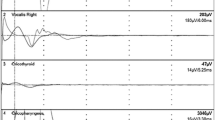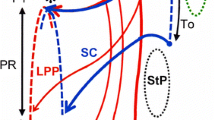Abstract.
Responsive areas for velopharyngeal closure were examined by recording diaphragmatic and superior pharyngeal constrictor activities of anesthetized rabbits. Pressure stimulation was applied with a cotton applicator to the mucosae of three pharyngeal areas: the anterior (palatal) and posterior walls of the nasopharynx and the posterior wall of the oropharynx. The intensity and duration of the stimulation were around 9.0 gf and 0.43 sec, respectively. Velopharyngeal closure was elicited more frequently from the posterior wall of the nasopharynx than the other two areas tested. The higher responsiveness of the posterior wall of the nasopharynx for velopharyngeal closure is suggested to be attributed to higher density and/or lower threshold of pressure receptors in this area than those in the other two areas tested. Possible physiological implications of the present results are discussed.
Similar content being viewed by others
Author information
Authors and Affiliations
Rights and permissions
About this article
Cite this article
Miyaoka, Y., Inoue, M., Shimada, K. et al. Reflexogenic Areas for Velopharyngeal Closure in Rabbits. Dysphagia 13, 156–159 (1998). https://doi.org/10.1007/PL00009566
Issue Date:
DOI: https://doi.org/10.1007/PL00009566




